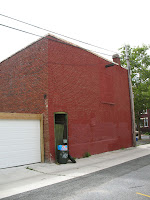When I was a little boy one of my many
tasks, in addition to cutting lawns and washing cars, was to shine
father’s shoes at night for the morning. Father was a busy, hard
driven man with a powerful career. I somehow naively felt honored as a little kid. Perhaps I
rationalized the honor of this chore by speculating that father just didn’t
know how to do this – especially with my electric buffer! One day he said to me
(always in testing mode) “Which part of the shoe do you think is the most
important and why?” I said “The toe because that’s what people see first.” He
seemed pleased with the answer – but no tip.
Why do I relate this tangential personal
vignette? It’s because people tend to look at buildings in the same way. It’s
the front that seems to count the most. Everything else is secondary. But
buildings are always 4-square. They have many faces and many lives.
As alleys are being “rediscovered”
and gaining respect throughout America, the rear and sides of buildings are
beginning to take on ever-greater significance. So too are the alley buildings
themselves. It was once said that the mark of a well-designed car is that it
looks integrated and beautiful from every angle. So it is with buildings.
The stable at the corner of Q and
3rd (1600 Rear) was built in 1900 as a private stable (19’ x 31’) by
the acclaimed D.C. architect Julius Germuiller to accompany the Victorian home in
the front of the property what had been built 5 years earlier. This stable has
features that are highly unusual for a D.C. stable.
- The quality of the design and construction is sophisticated as seen by the corbels and cornices
- The hayloft
door is on the side of the building rather than the front (rather than above
the carriage entrance) because there is access from the alley
- The stable is
positioned at 90 degrees to the home (not in tandem)
- The stable is “freestanding” with all sides of the stable clearly visible
- The stable is at the entrance to the alley
- The stable faces the street as part of the streetscape rather than the interior of the block
- There is liberal use of windows, some of which have likely been added over time.
This stable on 11th Street is another
example of a rare streetscape stable.
Restored ghost signage with new 9th Street advertising added, draws people into the alley
Ghost signage with many layers in a Charlottesville "mews"
Previously a garage, an auto body shop,
a dog wash, an art warehouse, this alley building is now home to a popular
sandwich shop that has been drawing people into an alley that would have until
recently intimidated most pedestrians giving them a sense of foreboding.
Georgetown
Bicycle Shop at an alley entrance
So what’s the point of this post?
(a) Buildings at the openings of alleys can act as magnets enticing people to
explore the interior of the alley. In a way, they are like store windows giving glimpses of what lies within.
(b) These
charming, and for the most part well preserved, little buildings scattered throughout the city make terrific
small homes (accessory dwelling units) and businesses for anyone who appreciates simplicity of living in a
very vibrant and increasingly “hip” city.








No comments:
Post a Comment